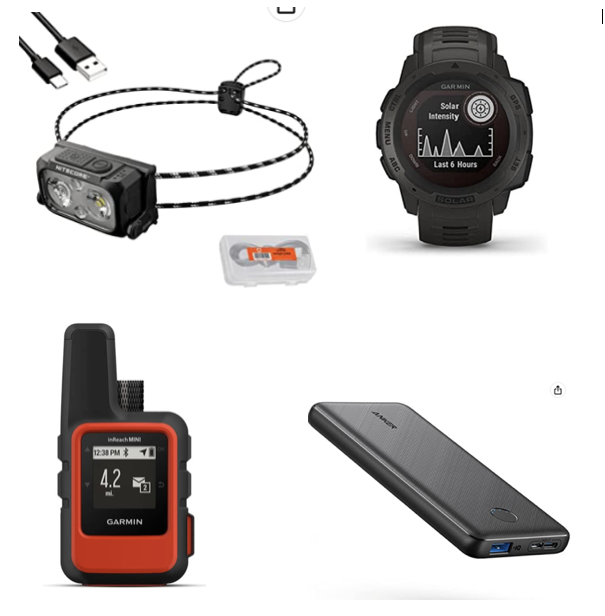By Rob Shaul
We received an email question this week asking to update my current outdoor gear recommendations. The below list is what MTI recommends for summer backpacking, car camping, and fly fishing trips.
Clothing
- Shorts: Outdoor Research Ferrosi Shorts
- Pants: Outdoor Research’s Ferossi Pants
- Underwear: Outdoor Research Echo Boxer Briefs
- Long Johns: Anything lightweight and synthetic
- Top Baselayer: Sitka Gear Core Lightweight Hoodie
- Top Midlayer (Optional): Kuiu Peloton 97 Fleece Zip-T Hoodie
- Puffy: Arcteryx Proton LT Hoody
- Rain Jacket: Black Diamonds’ Liquid Point Shell
- Shoes: Hoka One One Speedgoat
- Gloves: Outdoor Research fleece liner gloves
- Pack: Outdoor Vitals 45L Shadow Backpack
Pack
- Pack: Outdoor Vitals 45L Shadow Backpack
- Stuff Sacks: ultralitesacks.com
Sleep System
- Bivvy: Outdoor Research Helium Bivy
- Trekking Pole Tent (Optional): Tarptent Notch
- Sleeping bag/Quilt: 20-Degree Enlightened Equipment Revelation Quilt
- Sleeping Pad: Thermarest NeoAir Xlite
- Pillow: Thermarest NeoAir Xlite
Cooking
- Cooking: Jetboil Stash
- Snacks: Cliff Protein Builders Bar, GU Stroopwafels
- Water Filter: Katadyn BeFree
- Water Bladder: Platypus Hydration Bladder
- Coffee: Starbucks Columbia Via
- Camping Cup: Sea to Summit Xcup
Extras
- Headlamp – Nitecore NU25 UL 400 Lumen – USB rechargeable
- Watch – Garmin Instinct Solar – great for altitude, and laying down GPS waypoints. Lasts forever with solar charging.
- Emergency Communication – Garmin Inreach (won’t leave home without it)
- Navigation – iPhone with GAIA GPS and Onxmaps Applications – simple and effective
- Powerbank: Anker 313 – use it to recharge the phone and headlamp (if needed).
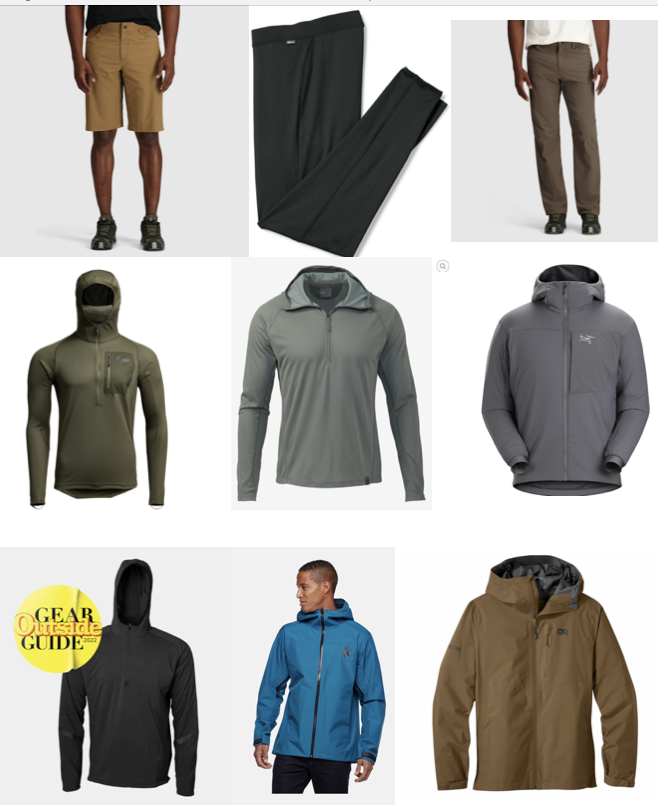
Summer Clothing System
Shorts / Long John Combo/Pants
I wear shorts backpacking and/or summer big game scouting. At night/mornings I’ll put on a lightweight pair of long johns. For shorts, we recommend nylon, not polyester. It’s more durable and dries faster. A great option is the Outdoor Research Ferrosi Shorts– but any longer-inseam, nylon short, that fits, will work. I’ll wear a lightweight pair of long johns to sleep and for the evenings/early mornings. I have a pair of old REI Lightweight bottoms, but am not partial to any brand. Just go lightweight and synthetic.
Underwear? Outdoor Research Echo Boxer Briefs are hard to beat. If the trip is a week or less, don’t bring a second pair.
Pants? I always wear pants for early September bowhunting – when it can still be hot. Again, nylon is best and Outdoor Research’s Ferossi Pants, or Prana Stretch Zion Pants work well – but any nylon pant that fits will work. When it’s hot, roll up the bottoms to just below your knees, making them into knickers or “capri” pants. It’s amazing how much cooler you’ll feel when your calves/shins can breath!
One note, fit is by far the most important. A cheap pair of pants/shorts, or a pair on sale that don’t fit will be money down the drain. It’s much better to pay full price for pants/shorts that fit …. you’ll actually wear them.
Baselayer
I prefer a synthetic long sleeve top, hooded top for all my summer outdoor activities. The outdoor industry calls this piece a “sun hoodie.” Long sleeves keeps us cooler and deploying the hood when hiking in hot sun has a pretty incredibly cooling effect. My favorite baselayer is the Sitka Gear Core Lightweight Hoodie but many companies make these and this one from amazon.com works well and is just $22. Fit is important – you’ll want it loose. As an added bonus, the hood also acts as a lightweight hat while sleeping.
A note on Merino – I don’t like merino for hiking/scouting/hunting other than socks (see below). I’ve found merino simply does not dry as fast as synthetics. A few year’s ago I killed a bull elk near dark in late September, and it was 11pm by the time I made it back to my truck with the first half of boned out meat in my pack. It was below freezing in the creek bottom where my truck was, and when I arrived I was sweaty. I’m small enough to sleep in the back seats of my truck, and it was midnight by the time I’d eaten dinner, and stowed all my gear. I’d worn a merino camo base layer and hoodie, but still wasn’t dry from sweat when I layed down to sleep. I spent the first 30 minutes in shivering myself dry before I could sleep. This has never happened wearing synthetic clothing.
Mid-Layer
I’ve yet to find the perfect mid-layer piece and have worked hard, but unsuccessfully, to totally eliminate this layer from my kit. Often I don’t need to wear a mid layer during summer backpacking and early season bowhunting trips. A raincoat over the sun hoody protects from the wind, and most the time, I’ll skip the mid layer and jump right to a puffy.
While I’ve worked to eliminate this layer, I’ve yet to be totally successful. But I have found a better mid-layer piece – a super lightweight fleece hoody, specifically the Kuiu Peloton 97 Fleece Zip-T Hoodie. This unique piece weighs just 5 oz. and is the lightest fleece I’ve ever found – but still heavier than a base layer. It’s just the right amount of insulation for the evenings and early mornings – and in the morning, I can even begin hiking wearing the 97 hoodie without having to stop 10 minutes in to shed a layer. I’ve yet to see another company that offers a similar piece made of fleece. But … another piece I’ve found works, but is slightly heavier and warmer is the Outdoor Vitals Ventus Active Hoodie. This piece is just 7 oz., warmer, and offers some wind protection.
Puffy
I always bring a hooded puffy – some don’t, but in my experience, it can get cold fast, at altitude – like a 40-degree drop in 60 minutes – and a only a hooded puffy jacket can protect you well from the cold in a situation like that. As well, in the evenings and early mornings, a warm puffy is a simple creature comfort – and wearing it while sleeping allows me to bring a lighter sleeping bag.
I prefer a lightweight down or synthetic hooded jacket that weighs no more that 13 ounces or so. In my pack now is the Arcteryx Proton LT Hoody. Aim for a hooded jacket that weighs less than 13 ounces. Most gear manufacturers make these including brands like REI and LLBean – so you can save money.
Rain Jacket
I never leave the trailhead without a gore-tex rain jacket in my pack. I’ll use this pieces for wind protection as well, and sometimes will don it over my base and/or mid layers when it’s not cold enough for a puffy. You want a jacket that weighs no more than 16 oz. Many companies offer cheaper, coated waterproof rain jackets like the Marmot Eco Precip jacket – but I prefer gore-tex for durability and longevity. Black Diamonds’ Liquid Point Shell is a solid option as is the OR Foray II Jacket. One note here on layering … your rain jacket has to be big enough to fit comfortably over your sun hoody, mid-layer fleece, and puffy. Rain pants? Not needed for summer backpacking, unless the forecast is an extended, dreary, wet trip.
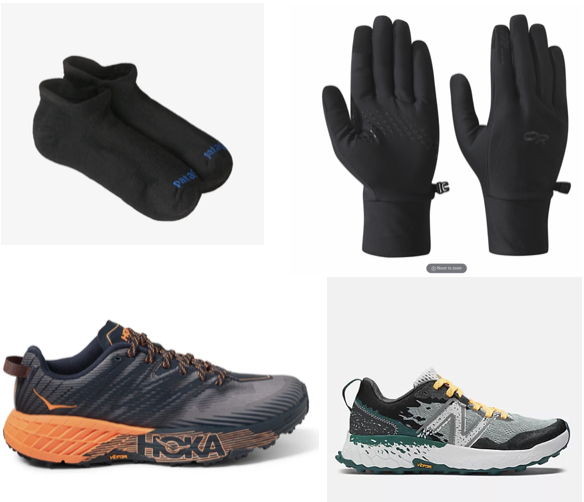
Socks
I prefer merino wool, ankle-high socks. I’ll wear one pair, and bring another in my pack in case my feet get wet during the day and I need a dry pair to sleep in. I’ve had great luck with Patagoinia’s Anklet Lighweight Performance Socks. Several pairs of these socks have lasted 10+ years of daily wear.
Hat / Gloves
Any ball cap will do. Because of my sun hoodie, fleece hoodie, and puffy hoody, I don’t need to bring a warm hat. For gloves, I bring along lightweight Outdoor Research fleece liner gloves. I don’t wear them often – but do wear them every night while sleeping – and they allow me to sleep with my arms outside the sleeping bag/quilt.
Shoes
I like trail runners for summer backpacking/scouting. My current favorites are Hoka One One Speedgoat trail runners. I have a wide foot, and Hoka makes these in wide sizes. Hoka pioneered heavily cushioned trail runners and other shoes, but many others have followed. I’m currently testing a pair of New Balanced Fresh Foam X Hierro trail runners. This time of year, it’s easy to find these shoes on sale.
A final note on fit and extra clothing …. I mentioned this before but will repeat it again … by far, fit is the most important element of choosing outdoor clothing. If it doesn’t fit, you won’t wear it. This is frustrating because fit is inconsistent between brands, and also within brands between different products … you’ve got to try it on and make sure it fits. If it’s a great deal on sale, but doesn’t fit – it’s a waste of money. Much better to go to a retail store, try it on, make sure it fits, and pay full price.
Extra clothing? For a trip 1 week or less, the only extra clothing I bring is an extra pair of socks in case my feet get wet and don’t have enough time to dry before bed time. For a week+, I’ll bring and extra pair of socks and an extra pair of underwear. That’s it!
Backpack
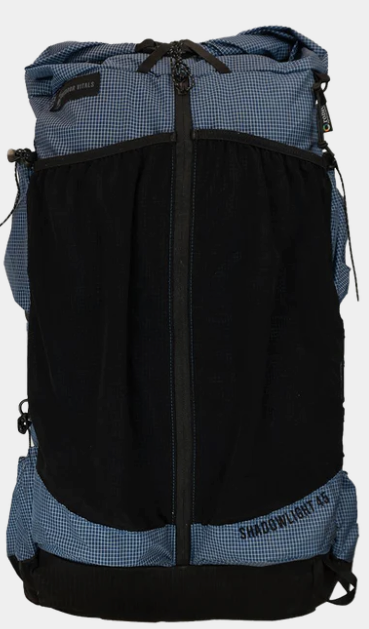 I’ve found the smaller your pack, the less unnecessary stuff you take. For backpacking, I try not to go over 40L pack, but 30-50L will work.
I’ve found the smaller your pack, the less unnecessary stuff you take. For backpacking, I try not to go over 40L pack, but 30-50L will work.
Also important is the backpack weight – aim to buy a pack the weighs less than 3 pounds and costs under $200.
The Outdoor Vitals 45L Shadow Backpack fits the bill for summer backpacking.

Sleep System
Ninety-five percent of the time I’ll choose a bivy sack over a tent. Once you start using a bivy sack, you’ll find the hassle of finding a flat spot for, and setting up a tent too much to bear! My bivy sack of choice is the Outdoor Research Helium Bivy. It’s cheap, light (less than 1 pound) and has kept me dry in many a short night time rain shower. As well, the bivy sack adds 10-15 degrees of warmth to your sleep system.
For than 5% of the time when weather threatens and I need a tent or for a week+ trip I take a tent – specifically the Tarptent Notch. This is a trekking pole tent (I use trekking poles), weighs less than two pounds, and is bomber in wind and bad weather. Additionally, I can leave the interior and just use the fly to save even more weight. It’s a bomber set up.
I use a quilt, instead of a sleeping bag, specifically the 20-Degree Enlightened Equipment Revelation Quilt. I’ll wear my 97 Fleece Hoodie, with hood up to sleep, and this quilt, and Helium Bivy keep me plenty warm. It weighs only around 20 oz.
Sleeping Pad – Thermarest NeoAir Xlite. Super comfy, warm and light.
Pillow? – until last year I never bothered … I’d just roll up my puffy jacket and us it as a makeshift pillow, but on a whim, last year I purchased a Sea to Summit Aeros Ultralight Inflatable Pillow. Best $40 I ever spent and at 2 oz – its well worth it! Now I won’t go without one.
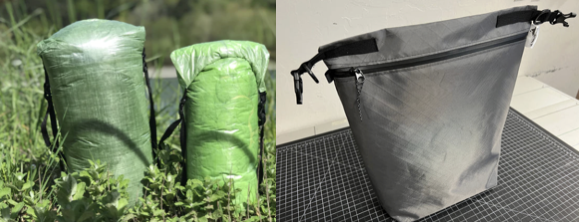
Stuff Sacks
After my third Outdoor Research stuff sack failed on me, I searched for a new option and purchased two compression sacks and a food bag from a small, direct to consumer bag maker, ultralitesacks.com I found on Etsy. Luke there is awesome and his bags, made from the super strong and waterproof, dyneema composite fabric are fairly priced and bomber. Mine have lasted 4+ years now, with no issues. Since I purchased my bags from him, Luke has expanded into building ultra lite backpacks also. For short trips, all my food plus my cook system goes into the food back, my sleep system (quilt, pad, bivy or tent) go into one of the compression sacks (size large), and layers (puffy, mid layer, rain jacket, extra pair of socks) go into the other compression sack (medium). Nice thing about Luke’s sacks is they are waterproof … so it if does rain, or I fall into some water with my pack on, my clothes and quilt will stay dry.
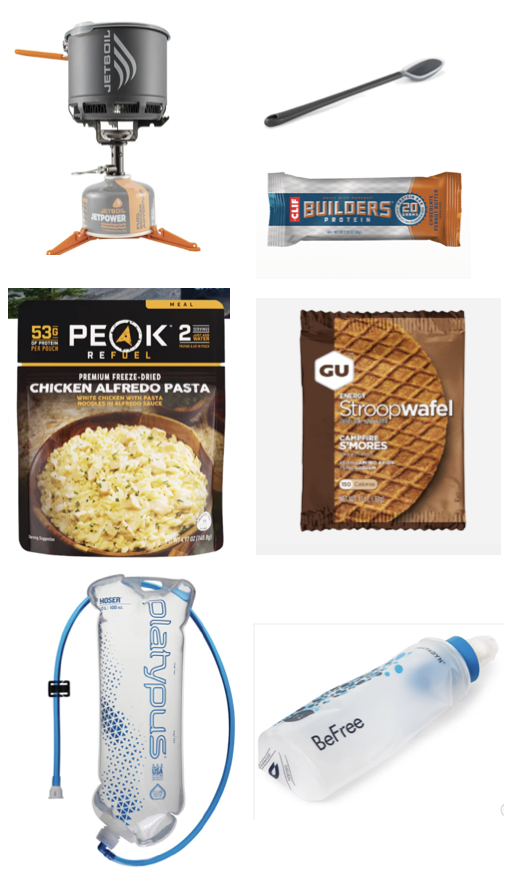
Cook System
Stove, Spoon, Cup
It’s hard to beat the Jetboil Stash system. Super light, packs into itself, boils water fast. I bring along a GSI Long Handled Spoon – and for eating freeze-dried backpacking meals, it’s a game changer.
Food / Hydration / Water Filtration
Breakfast and lunch are generally a Cliff Protein builders Bar, and I’ll have a Peak Refuel freeze dried meal for dinner. Peak Refuel meals are expensive, but have a lot of protein compared to other brands, and the portioning is just right. Backpacker Pantry meals are my second favorite. Between meals I’ll eat GU Stroopwafels – which offer about the most calories per ounce out there, and aren’t as messy as gels. I’ll pack 4x Stroopwafels per day. I use as Platypus Hydration Bladder for my water, and Katadyn BeFree water filter to purify my water. The BeFree is the most simple and fastest filtration system I’ve found.
I’m big on coffee in the backcountry, and my goto are Starbucks Columbia Via instant coffee packets. For a Cup I bring a long a collapsible silicone Sea to Summit Xcup. It’s amazing what a jolt of caffeine will do for your energy and spirits in the middle of the afternoon on a hot day, 10 miles from the trailhead! During the day I’ll just make cold brew. In the evenings and morning, I’ll heat up some water for my coffee. I pack 4 Via packets per day.
Extras
Headlamp – Nitecore NU25 UL 400 Lumen – usb rechargeable
Watch – Garmin Instinct Solar – great for altitude, and laying down GPS waypoints. Lasts forever with solar charging.
Emergency Communication – Garmin Inreach (won’t leave home without it)
Navigation – Iphone with GAIA GPS and Onxmaps Applications – simple and effective
Powerbank: Anker 313 – use it to recharge phone and headlamp (if needed).
Questions, Comments, Feedback? Email rob@mtntactical.com
You Might Also Like Jetboil Deep Dive: Small Canister 22 Meals

